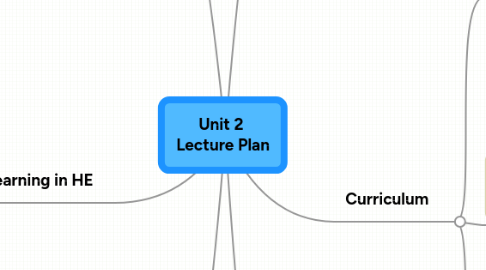
1. Students
1.1. Kuh (2001) College Students today
1.1.1. "The Kids are alright" Rant about rants: Academic rants about how students were better in the old days are not empirically supported. Massification and Unviersal access bring with them diversity.
1.2. Pascarella (2006) How College affects students
1.2.1. #RANT 10 directions for future research on post-graduation paths. Lack of relevant, replicable, empirical research. Current research does not acknowledge diversity and width of students today (Kuh!)
1.3. Marambe (2000)A cross-cultural comparison of student learning patterns in Higher Education
1.3.1. Comparison betwee patterns in The nederlands, Sri Lanka and Malaysia Comparison based on Hofstede's 5 dimensions of Culture Cultural patterns do not necessarily have an effect on learning, but it can influence it. Disciplinary differences (Beecher!)
2. Teaching and Learning in HE
2.1. Fry et al (2009) Understanding student learning
2.1.1. Different approaches to study: Constructivism: "Constructing and amending structures in the mind that hold knowledge" or schemata. Experiences lead to changing schemata and LEARNING. KNowledge is constructed through transformation Approaches to study= approaches to learning Deep learning approach vs Surface learning approach vs strategic learning approach. "Stephen Fry, Bob the Builder and Sherria"
2.2. Wang (2012) Bigg's Constructive Alignement
2.2.1. Constructive alignement Constructivism (learners learn from what they do to learn) Aligning TLAs (teaching and Learning Activities) and Learning Outcomes in a conscious effort to provide a specific goal. Students in "constructively aligned courses" are more likely to use deep learning approaches.
3. Relationship: Teaching and Research
3.1. Brew (2006) Relationaship between teaching and research
3.1.1. Conceptualising the relationship between research and teaching Traditional Model: Research is knowledge generation Teaching is dissemination of existing knowledge They go on different directions A New Model: Dynamic, focused on all elements of the process Interwoven and overlapping "Scholarly communities of practice"
3.2. Marambe (2000)A cross-cultural comparison of student learning patterns in Higher Education
3.2.1. Comparison betwee patterns in The nederlands, Sri Lanka and Malaysia Comparison based on Hofstede's 5 dimensions of Culture Cultural patterns do not necessarily have an effect on learning, but it can influence it. Disciplinary differences (Beecher!)
4. Disciplines and Knowledge cultures
4.1. Barnett et al (2001= Conceptualising Curriculum change
4.2. Neumann & Beecher (2002) Teaching and learning in their disciplinary contexts
4.2.1. Study focus: Comparing and contrasting T & L across the 4 disciplinary categorizations: knowledge and social context.
4.2.2. Objectives and methods of teaching / learning hard and soft (pure - applied) disciplines are different: hard ones are more linear, quantitative, exact, focused on knowledge building, while soft ones are more "social", subjective, qualitative, focused on personal development and analytical skills.
4.3. Nerland (2012) Professions as knowledge cultures
4.3.1. Similarities between knowledge cultures and academic tribes?
4.3.2. Shared norms, values, governance across 3 professions: teaching, nursing and engineering
4.4. Becher (1994) Significance of Disciplinary differences
4.4.1. Disciplines are the the life blood of HE - they provide the main organizing base and social frame.
4.4.2. 4 major groupings: hard - soft + pure - applied (urban - rural, etc).
4.4.3. Each disciplinary grouping has its own specific norms, codes of conduct, language, etc... therefore, could we call disciplinary groupings academic tribes?
4.4.4. Disciplinary grouping / differentiation has implications onto HE research and policy: on macro, meso and micro level . Research on one level may benefit practice on another.
5. Curriculum
5.1. Lattuca & Stark (2009) Curriculum as Academic Plan
5.1.1. Conceptualization of the curriculum as an academic plan
5.1.2. Student needs should take the prominent position
5.1.3. The elements of the academic plan are interconnected and subject to internal and external pressures, which should lead to continuous evaluation and adaptation. Which are the internal and external pressures? What is their impact onto curriculum design?
5.2. Barnett et al (2001) Conceptualising Curriculum change
5.2.1. Focus on undergraduate curriculum and its change across subject areas (in England
5.2.2. Knowledge fields define the curriculum (values and practices)
5.2.3. Production and application of (academic) knowledge is now changing: from "is it true?" to "is it useful?". Focus is now on effectiveness, output
5.2.4. New technologies play an important role
5.2.5. Performativity: link between HE and the labor market: what you CAN DO, not what you know. This leads to the shift from the traditional to the emerging curriculum (from knowing to knowing how; from disciplinary knowledge to transferable skills)
5.2.6. 3 domains of curriculum: knowledge (discipline) - action (practical competencies, or skills set) - self (identification within subject area)
5.2.7. Changes occur across all knowledge domains due to internal but more so external expectations
5.3. Tight, M (2012). Researching Higher Education. SRHE/ Open University Press pp. 65-82
5.3.1. Threshold concept: transformative way of thinking and understanding brought about by learning
5.3.2. The curriculum reinforces the knowledge / action / self domains
5.3.3. Perspectives on what (should) constitute a curriculum: - experiental and independent earning - inderdisciplinarity - problem based learning - reflection - skill development, etc.
6. Evaluation in HE
6.1. Henkel (1998) Evaluation in HE
6.1.1. Evaluation is associated with modernization, the growth of the public sector, etc, and has the following concerns: - Demand for new knowledge to contribute to society - Cost - effectiveness / benefit; budgeting concerns - Programme analysis - Outcomes
6.1.2. Basic form of academic evaluation: peer review. But, who are, and should be the peer reviews? What are we evaluating? Why?
6.2. Tight, M (2012) Researching Higher Education. SRHE/ Open University Press, pp. 104-116
6.2.1. Link between QA, massiffication and accountability
6.2.2. Course evaluation focused on student / stakeholder satisfaction; and validity of course evaluation techniques, BUT: student satisfaction may depend on whether or not they were satisfied with the teacher.
6.2.3. Therefore, the main concern is: Are we really measuring what we set out to measure? We strive to measure quality, but what is quality?
